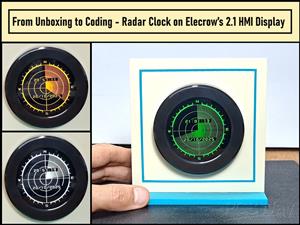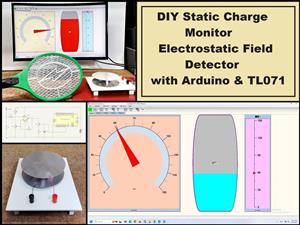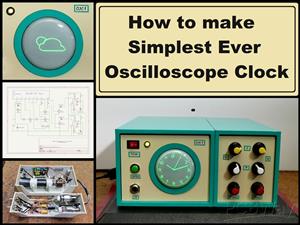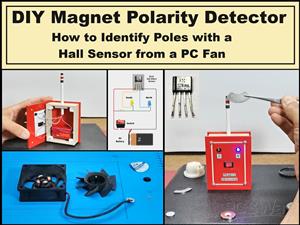|
|
ZVS driver based Induction hetaer module (Zero Voltage Switching) |
x 1 | |
|
|
50V/50A Power source |
x 1 |

|
Soldering Iron Kit |
Testing 2500W Large Induction Heater
An induction heater is a device that uses electromagnetic induction to heat objects. It consists of a coil of wire through which a high-frequency alternating current (AC) is passed, and this coil generates a magnetic field around it. When a conductive material is placed within this magnetic field, it induces electric currents, known as "eddy currents," within the material. These eddy currents generate heat due to electrical resistance in the material, causing it to become hot.

These days, I received this device as a gift from a friend who is a dentist by profession, because it had been sitting in his garage for several years and he had not used it. I immediately decided to study it in more detail so that I could find some application for it. Analyzing the outside, it is immediately seen that it is most likely an induction heater, especially considering this copper coil made of a pipe with a diameter of 7mm.
But to look inside, I first have to remove these cooling fans. Now the PCB is clearly visible and so we can start the analysis. The device contains a very small number of components, including 6 power mosfets IRFP260 mounted on a heatsink, several high-quality MKP capacitors connected in combination, several fast and zener diodes, and two large chopper coils. Here you can see that the device is powered with a voltage of 48 Volts and a current of up to 50 Amps, which by simple multiplication we can calculate that it is a device with a power of 2500 watts or 2.5 kilowatts

And so according to the components, it is not at all difficult to conclude that it is a standard Zero Voltage Switching (ZVS) driver that is used to drive high-frequency resonant converters, typically for applications like induction heating, power supplies, and ballast lighting. According to the size and shape of the coil, we can conclude that it is an Induction Heater with high power. The mosfets are interconnected in two groups, each of three in parallel connection, so that they can withstand a higher current.
First I will put the fans back in place and test the unit.
And as you can imagine, it is very difficult to find a power supply with these features. Nowadays switching mode power supplies are widespread, but this is a special case where extremely high currents flow. In such conditions, these power supplies often experience instability during operation, change in characteristics, and even damage to the power supply.

Fortunately, I had two powerful transformers with a power of 1500 watts each, and they have a secondary voltage of 17V. These are transformers taken out of an old failed UPS unit. As you can see, I connected the primaries in parallel, and the secondary windings in series, so at the output I got an AC voltage of 34 V / 3000 watts. This is exactly what I need, because after rectifying and filtering the alternating voltage, I get 45 volts DC voltage under load.

As a rectifier, I use a Gretz type KBPC 5010 designed for voltages up to 1000V and a current of 50A. Next is a filter of several electrolytic capacitors with a total value of 4000µF. For safety, I also installed an automatic fuse, initially with a value of 20 Amps
And now let's see how the device works in real conditions. During the test I will use first small and then larger objects and at the same time I will read the total consumption with Wattmeter, because at the moment I do not have an Ammeter for large currents (so-called current clamp).





And finally a short conclusion.
The device is solidly made, and for a power of up to 1.2 kilowatts, cooling fans are not needed at all. I actually didn't use the fans during testing. This device is sold online for a price of about $100 which is actually some real amount. A much bigger problem is the power supply for it, so if we don't have an alternative like in my case, the cost of the power supply would several times exceed the price of the device itself. This induction heater can be used with graphite crucible for smelting gold, silver, copper, aluminum and other metals. It can also be used to generate High Voltage using a flyback transformer, wireless power transfer, tesla transformer, and other experiments that I will describe in some of my next videos.
SAFETY NOTE: Please do not attempt to recreate the experiments shown on this video unless you are familiar with High Voltage Safety Techniques! Direct Current even above 60V maybe lethal, even when the AC supply voltage has been disconnected due to the stored energy in the capacitors. I have no responsibility on any hazards caused by the circuit. Be very careful.

Testing 2500W Large Induction Heater
- Comments(1)
- Likes(4)
-
 Z Mitchell
Apr 01,2025
Z Mitchell
Apr 01,2025
-
 micbanand
Nov 13,2024
micbanand
Nov 13,2024
-
 Engineer
Oct 17,2024
Engineer
Oct 17,2024
-
 Engineer
Jul 19,2024
Engineer
Jul 19,2024
- 0 USER VOTES
- YOUR VOTE 0.00 0.00
- 1
- 2
- 3
- 4
- 5
- 6
- 7
- 8
- 9
- 10
- 1
- 2
- 3
- 4
- 5
- 6
- 7
- 8
- 9
- 10
- 1
- 2
- 3
- 4
- 5
- 6
- 7
- 8
- 9
- 10
- 1
- 2
- 3
- 4
- 5
- 6
- 7
- 8
- 9
- 10
 More by Mirko Pavleski
More by Mirko Pavleski
-
 Arduino 3D Printed self Balancing Cube
Self-balancing devices are electronic devices that use sensors and motors to keep themselves balanc...
Arduino 3D Printed self Balancing Cube
Self-balancing devices are electronic devices that use sensors and motors to keep themselves balanc...
-
 How to make simple Variable HIGH VOLTAGE Power Supply
High Voltage Power Supply is usually understood as a device that is capable of generating a voltage...
How to make simple Variable HIGH VOLTAGE Power Supply
High Voltage Power Supply is usually understood as a device that is capable of generating a voltage...
-
 DIY 5-Day Rainfall Forecast Device - ESP32 E-Paper Project
In several of my previous projects I have presented ways to make weather stations, but this time I ...
DIY 5-Day Rainfall Forecast Device - ESP32 E-Paper Project
In several of my previous projects I have presented ways to make weather stations, but this time I ...
-
 Build simple Retro Style VFO (Variable frequency oscillator) with Crowoanel 1.28 inch Round Display
Today I received a shipment with a Small round LCD display from Elecrow. The device is packed in tw...
Build simple Retro Style VFO (Variable frequency oscillator) with Crowoanel 1.28 inch Round Display
Today I received a shipment with a Small round LCD display from Elecrow. The device is packed in tw...
-
 Human vs Robot – Rock Paper Scissors with MyCobot 280 M5Stack
Today I received a package containing the few Elephant Robotics products. The shipment is well pack...
Human vs Robot – Rock Paper Scissors with MyCobot 280 M5Stack
Today I received a package containing the few Elephant Robotics products. The shipment is well pack...
-
 How to Build a Simple Audio Spectrum Analyzer with Adjustable Settings
An audio spectrum analyzer is an electronic device or software tool that measures and visually disp...
How to Build a Simple Audio Spectrum Analyzer with Adjustable Settings
An audio spectrum analyzer is an electronic device or software tool that measures and visually disp...
-
 How to Make a Digital Clock on a Vintage B&W TV using Arduino
These days I accidentally came across this small retro Black and White TV with a built-in Radio, so ...
How to Make a Digital Clock on a Vintage B&W TV using Arduino
These days I accidentally came across this small retro Black and White TV with a built-in Radio, so ...
-
 Build a $10 Function Generator with Frequency Meter for Your Lab
A function generator is a piece of electronic test equipment used to generate various types of elec...
Build a $10 Function Generator with Frequency Meter for Your Lab
A function generator is a piece of electronic test equipment used to generate various types of elec...
-
 From Unboxing to Coding - Radar Clock on Elecrow’s 2.1 HMI Display
Today I received a shipment with a large round LCD display from Elecrow. The device is packed in two...
From Unboxing to Coding - Radar Clock on Elecrow’s 2.1 HMI Display
Today I received a shipment with a large round LCD display from Elecrow. The device is packed in two...
-
 Making a Retro Analog NTP Clock with Unihiker K10 - Arduino IDE Tutorial
Some time ago I presented you a way to use standard Arduino libraries on the Unihiker k10 developme...
Making a Retro Analog NTP Clock with Unihiker K10 - Arduino IDE Tutorial
Some time ago I presented you a way to use standard Arduino libraries on the Unihiker k10 developme...
-
 Build a Cheap & Easy HF Preselector - Antenna Tuner
HF antenna preselector is an electronic device connected between an HF radio antenna, and a radio r...
Build a Cheap & Easy HF Preselector - Antenna Tuner
HF antenna preselector is an electronic device connected between an HF radio antenna, and a radio r...
-
 DIY Static Charge Monitor - Electrostatic Field Detector (Arduino & TL071)
A Static Charge Monitor also known as a Static Field Meter or Electrostatic Voltmeter is a device u...
DIY Static Charge Monitor - Electrostatic Field Detector (Arduino & TL071)
A Static Charge Monitor also known as a Static Field Meter or Electrostatic Voltmeter is a device u...
-
 XHDATA D-219 Radio Short Review with complete disassembly
Some time ago I received an offer from XHDATA to be one of the first test users of their new radio m...
XHDATA D-219 Radio Short Review with complete disassembly
Some time ago I received an offer from XHDATA to be one of the first test users of their new radio m...
-
 How to make Simplest ever Oscilloscope Clock
An oscilloscope clock is a unique and creative way to display the time using an oscilloscope, which...
How to make Simplest ever Oscilloscope Clock
An oscilloscope clock is a unique and creative way to display the time using an oscilloscope, which...
-
 DIY Digital Barograph with BME280 and ESP32 - 24 Hour Pressure Trends
A barograph is a self-recording barometer that continuously measures and records atmospheric pressu...
DIY Digital Barograph with BME280 and ESP32 - 24 Hour Pressure Trends
A barograph is a self-recording barometer that continuously measures and records atmospheric pressu...
-
 Build a Raspberry Pi Pico SDR Radio with Waterfall Display
Software-defined radio (SDR) is a radio communication system where components that have traditional...
Build a Raspberry Pi Pico SDR Radio with Waterfall Display
Software-defined radio (SDR) is a radio communication system where components that have traditional...
-
 DIY Magnet Polarity Detector - How to Identify Poles with a Hall Sensor from a PC Fan
Recently, while working on a project, I needed to determine the polarity of several permanent magne...
DIY Magnet Polarity Detector - How to Identify Poles with a Hall Sensor from a PC Fan
Recently, while working on a project, I needed to determine the polarity of several permanent magne...
-
 Light Meter Project - Making Dfrobot Unihiker K10 Work with Standard Arduino Libraries
The other day I received a shipment with a UNIHIKER K10 development board from DFRobot, which I rec...
Light Meter Project - Making Dfrobot Unihiker K10 Work with Standard Arduino Libraries
The other day I received a shipment with a UNIHIKER K10 development board from DFRobot, which I rec...
-
-
mammoth-3D SLM Voron Toolhead – Manual Drill & Tap Edition
164 0 0 -
-
AEL-2011 Power Supply Module
683 0 2 -
AEL-2011 50W Power Amplifier
584 0 2 -
-
-
Custom Mechanical Keyboard
785 0 0 -
Tester for Touch Screen Digitizer without using microcontroller
409 2 2 -
Audio reactive glow LED wristband/bracelet with NFC / RFID-Tags
371 0 1 -
-












































